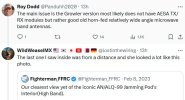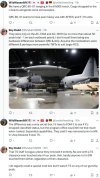Install the app
How to install the app on iOS
Follow along with the video below to see how to install our site as a web app on your home screen.
Note: This feature may not be available in some browsers.
You are using an out of date browser. It may not display this or other websites correctly.
You should upgrade or use an alternative browser.
You should upgrade or use an alternative browser.
F-35 Lightning II
- Viestiketjun aloittaja Hejsan
- Aloitus PVM
Patria ja moottorijätti Pratt & Whitney solmivat sopimuksen F-35-moottorien tuotannosta Suomessa
Kokoonpano- ja huoltotyö toteutetaan Nokialla.

Patria ja Pratt & Whitney ovat allekirjoittaneet sopimuksen F135-moottoreiden tuotannosta osana Suomen F-35 -teollisen yhteistyön ohjelmaa | Patria
Patria ja Pratt & Whitney ovat allekirjoittaneet sopimuksen F135-moottoreiden tuotannosta osana Suomen F-35 -teollisen yhteistyön ohjelmaa
Viimeksi muokattu:
mechanicus
Kenraali
Jep. Varamittariin tulee tyypillisesti varmistettu sähkönsyöttö ja pitotstaattiset letkut. Ainoa kytkentä päätietokoneeseen on todennäköisesti diskreettisignaali, jolla varamittari kertoo toimivansa oikein. Kaikki muu tapahtuu itsenäisesti varamittarin omassa laitteistossa.
wargame
Kapteeni

Air Force Confirms F-35As Are Mission Capable Half the Time
The Air Force says its F-35As are mission capable only about half the time, but that MC rates don’t tell the whole readiness story.
F-35 on ollut vissiin koko ajan ongelmia varaosasaatavuuden kanssa. Onko systeemi liian ”lean”?
Air Force Confirms F-35As Are Mission Capable Half the Time
The Air Force says its F-35As are mission capable only about half the time, but that MC rates don’t tell the whole readiness story.www.airandspaceforces.com
LM:lla pitäisi olla aika kattava käsitys ainakin yleisimpien varaosien tarpeen suhteen ja konemäärän kasvaessa näiden osalta kausivaihtelunkin olettaisi tasaantuvan. Varaosatarpeen siis luulisi olevan ennakoitavissa. LM:llä luulisi olevan myös tieto koneiden lentotunneista ja tuntimäärää vastaavasta varaosatarpeesta ja sitäkin pitäisi voida ennakoida. Tunteja koko laivastolla alkaa olla siinä määrin, että on vaikea käsittää, miksi tätä puolta ei olla jo pikkuhiljaa saatu kuntoon.
F-35, Top Gun and Finland - Colonel (retd) Scott Davis

 podcasts.apple.com
podcasts.apple.com
Let's talk fighter jets, in two parts! Scott Davis, callsign "Lurch", is a fighter pilot with over 3600 flight hours in the F-15, F-16, F-18 and F-22 fighters. He's also attended and instructed at the TOPGUN courses in both US Navy and US Air Force. He now works for Lockheed Martin in the Nordics and he came on our show to talk to us about his career and the F-35, which is the new fighter jet for the Finnish Air Force.
In this first part of the series we talk about Scott's career through TOPGUN schools and what it was like to write the playbook for the first 5th generation fighters. We also discuss the differences between generations and especially how the 4th and 5th generation airframes differ. What's dog fighting like in a 4th generation versut 5th generation airplane?

Mighty Finland Podcast
Government Podcast · Every two weeks · Modernia maanpuolustustahtoa sosiaalisen median etulinjassa. Mighty Finland on Suomen suurin maanpuolustukseen, reserviläisyteen ja kokonaisturvallisuuteen liittyvä someyhteisö, ja tää on meidän podca…
mechanicus
Kenraali
F-35 Global Support Solutionin luvataan mm. laskevan operointikustannuksia 50%. En tiedä, mutta voi olla, että valmistajan kannattaa pitää systeemissä mahdollisimman vähän varaosia luvattujen kustannussäästöjen toteutumiseksi.
En tiedä millä mekanismilla varaosia järjestelmään hankitaan, kansallisia potteja siellä ei ole. (Suomella on tietyt huoltovarmuuskuviot, mutta ne eivät periaatteessa vaikuta normaaliolojen varaosakiertoon.)
En tiedä millä mekanismilla varaosia järjestelmään hankitaan, kansallisia potteja siellä ei ole. (Suomella on tietyt huoltovarmuuskuviot, mutta ne eivät periaatteessa vaikuta normaaliolojen varaosakiertoon.)
Panssari Salama
Respected Leader
Vitjasta 95% koski F-35 nykyistä tutkaa APG-81. Aikamoinen.Vitja F-35:n uudesta tutkasta. Aikamoinen.
Aloitus oli hämäävä kun siinä puhuttiin kerrottavan uudesta APG-85:sta, mutta tekstissä kaikki referenssit oli APG-81:een. Mun piti pariin kertaan varmistaa mitä aloituspostauksessa tarkalleen kirjoitettiin, että kummasta tässä nyt on kyse vai onko tekstissä virhe. Vasta ihan lopussa toteaa, että APG-85 ei tiedetä paljoakaan, mutta parantaa APG-81 ominaisuuksia ”by factor of two”. Eli uusi tutka tekee ilmeisesti vanhat ketjussa esitellyt temput, mutta tehokkaammin, tarkemmin ja nopeammin.
Avauspostaus oli tuossa mielessä melkoinen click-bait, mutta siitä huolimatta huikea yhteenveto nykyisestä APG-81 tutkasta. Jos info todellakin pitää paikkansa kaikkinensa, niin huikea kyky meille on tulossa. Ja niinhän monet ovat kommentoineet, että F-35 todella muuttaa pelin ilmassa eikä suurin tekijä siinä edes ole stealth.
Jännä tosiaan, aloituksessa ei sanottu, että thread on the F-35's new radar...Vitjasta 95% koski F-35 nykyistä tutkaa APG-81. Aikamoinen.
mutta sitten I'll go over the basic and some stuff on APG-85.
Oli 95% basiccia siis.
Ihan hyviä huomioita. Esim. meille tutumpaa termiä ECCM ei käytetä F-35 parissa vaan siellä termi on EP Electronic Protect.
Sitten Phased Arrayn toiminnasta keskustelua:
Viimeksi muokattu:
Katos joo. Mä luin ton aloitustwiitin ekan lauseen väärin kun oli @Panssari Salama kirjoittama ”uudesta tutkasta” jo rekisteröitynyt vastaanottimeen. Näin ne aivot huijaa lukijaa joskus.Jännä tosiaan, aloituksessa ei sanottu, että thread on the F-35's new radar...
Muok. Mutta siis ehdottomasti lukemisen arvoinen yhteenveto pitäen vain mielessä, että kertoo lähinnä nykyisestä tutkasta. Varsinkin näin vähän vähemmän vihkiytyneelle sopivan kompakti tietopaketti omaksuttavassa muodossa.
Täällä on parempaa juicea:
 aviationweek.com
Eli elso-SEADiin on luottoa ohjaajien parissa. DEAD jäänee tekemättä.
aviationweek.com
Eli elso-SEADiin on luottoa ohjaajien parissa. DEAD jäänee tekemättä.
Mutta tämä on karu huomio, että noin 2030 asti ovat kyvyttömiä standoffiin. Siitä Saab-kauppias olisi ehkä hieman vahingoniloinen...
there are some non-kinetic capabilities on the aircraft today. When I talk to the U.S. Air Force and some of the pilots, I think they're very confident that they can rely on those non-kinetic options that are on the jet today to deal with the suppression of enemy of air defense mission. That seems to be the sort of prevailing mood. They can't go into any details and I don't know them, but that is something to at least think about in the near term. So I mean they're not denuded of SEAD capability, or suppression of enemy air defense capability, in the interim possibly.
Podcast: The F-35 Has A Case Of Long COVID | Aviation Week Network
Listen in as Aviation Week editors discuss the GAO's latest report on the F-35 and explain what's hampering the now $2 trillion program.
Mutta tämä on karu huomio, että noin 2030 asti ovat kyvyttömiä standoffiin. Siitä Saab-kauppias olisi ehkä hieman vahingoniloinen...
Sitten on jotain puhetta kuinka ei ole enää testikone (matkustajalentokone F-35:n avioniikalla) Catbirdia, mitä tarvittaisiin taas.We were supposed to be getting standoff weapons for these aircraft, but they're all part of the TR-3 upgrade. So weapons like AARGM-ER, as I understand it, are part of the TR-3 upgrade. And several European nations are going down that route, buying AARGM-ER for the suppression and destruction of enemy air defenses role. Of course, if TR-3 is not available, that weapon is not available to them either.
So this would significantly limit deliveries of the F-35 in the interim unless they do certain things, one of which is buy a new cooperative avionics test bed, a CATBird. Now, this has been something I've been asking about with the program for several months. They used to have what they called a CATBird during the system development and demonstration phase. Once that was completed in 2018, they parked that aircraft, and they didn't replace it as they moved into Block 4.
And that became kind of relevant when we heard General Schmidt, the director of the JPO, say in a congressional hearing in December that he's got a problem right now with trying to test and certify the Block 4 software on the TR-3 hardware. And what he's saying is... Lockheed has that software. They put it into their ground-based system integration lab. It comes out. And it may have some glitches in it or it may be fine, but they know what they are, they know what those issues are. And then they put it in the jet and the jet goes flying and the software behaves completely differently in that flying real-world environment where it's interacting with the actual hardware in flight in that high vibration, high thermal environment type of experience.
That points to the reason why they had the CATBird in the first place, which was to simulate exactly the hardware and the software together on a flying aircraft that wasn't an F-35. They sort of host... They take another aircraft and they host all these systems, including the control surfaces on the aircraft, to simulate that environment and to get as much realism as possible in the testing before they send it to the F-35 test fleet.
So they don't have that, and they're saying... So this bill, if it's passed, would authorize the JPO to acquire a test bed, a CATBird, but even if they were to do that, this bill wouldn't get passed until the end of 2024.
The appropriations committees also would have to pass something similar to give them the actual money to spend on this. And then it would take a couple of years to actually acquire the aircraft, modify the aircraft, get it certified, and start testing it. So this is not going to fix any problems in the short term while they're trying to get through this sort of crisis in the TR-3 delivery delays.
So yeah, there's a lot of remediations built into this report, but there's no short-term fixes. These are all for long-term, addressing these issues in the long-term.
Viimeksi muokattu:
Hanski
Respected Leader
Tuo oli ihan hyvä tiivistys tutkan ominaisuuksista, ainakin minulle se oli suurimmaksi osaksi uutta tietoa!
Makea-Billin 75 sivun pamflettiin on otettu myös kantaa ym. Aviationweekin podcastissa.
 aviationweek.com
aviationweek.com
Saa helposti sen kuvan, että ennen Venlet/Bogdania oli vaarassa kaatua koko ohjelma, mutta nyt Block 4 myötä on melkein yhtä paha suo rämmittävänä. Siinä sivussa myy kuin häkä.
a year ago, Tom Burbage, the former program manager for Lockheed, he left in 2013, but he co-authored a book about the F-35 that covered the development issues, but still there was a firm conclusion that everything was worth it and that the program was a strategic success for the U.S. as well as for Lockheed. But Bill Sweetman has now come out with his sort of rebuttal to that. It's not quite a book. It's 75 pages. I don't know if you'd call that a book. It's sort of formatted more like a think tank report. That's how I read it. But he takes the opposite conclusion, that it's been a strategic failure. He argues that it's hollowed out the U.S. Air Force tactical combat capability by not delivering in the quantities and in the quality that was expected when the program, and certainly at the cost and schedule that wasn't envisioned originally.
And he brings up some interesting points also about just sort of the historic requirements and how they got set, just how the length and wingspan of the aircraft were set by these sort of artificial constraints that no longer exist. A great example he points out was the HMS Invincible had a 56 foot long mid-deck hangar elevator to bring the aircraft up. So that constrained the length of the aircraft to no more than 56 feet. And of course, all the F-35s are in that sort of 51, 52 feet length regime. Well, the Invincible was retired 13, 14 years ago, I think. the HMS Queen Elizabeth second is now out and it's got this 85 foot or something long mid-deck hangar elevator, but of course the F-35 length is still constrained at 51 feet. It's an issue of fineness ratio, as Bill Sweetman points out. So it's things like that that I think really illuminate some sort of fundamental decisions and architectural decisions that were made that complicated things down the road.
***we've had Tom Burbage's book. He co-authored that with a few other people. And now Bill Sweetman's sort of rebuttal to that. But I think we need something more. I would love to see a truly academic treatise on what this program is, what it means, how it got here, and how hopefully we can avoid some of these issues that keep popping up with the F-35 no matter how long the program exists.
Ash Carter wrote in his memoir about potentially walking out or actually walking out of a meeting with the CEO of Lockheed out of just frustration. Maybe even thinking about canceling the program.
But then they bring in Vice Admiral Venlet from the Navy. He kind of stabilizes it. Bogdan comes in, Lieutenant General Bogdan from the Air Force came into the JPO after that. And really that's where we started seeing it kind of really stabilize and kind of moving in the other direction, sort of a positive direction. They pulled off this really impressive production ramp-up, up until 2019. And things seemed to be going in the right direction. But then they moved into the Block 4 modernization program. And obviously COVID hit the supply chain, so we've seen production take a beating since then. And new cost increases, new development problems, new capability shortfalls, all hit the Block 4 program. So we're sort of in this downward trajectory for the program, except in the area of sales. And it's not clear when we're going to get out of this.
Podcast: The F-35 Has A Case Of Long COVID | Aviation Week Network
Listen in as Aviation Week editors discuss the GAO's latest report on the F-35 and explain what's hampering the now $2 trillion program.
Saa helposti sen kuvan, että ennen Venlet/Bogdania oli vaarassa kaatua koko ohjelma, mutta nyt Block 4 myötä on melkein yhtä paha suo rämmittävänä. Siinä sivussa myy kuin häkä.
Viimeksi muokattu:






